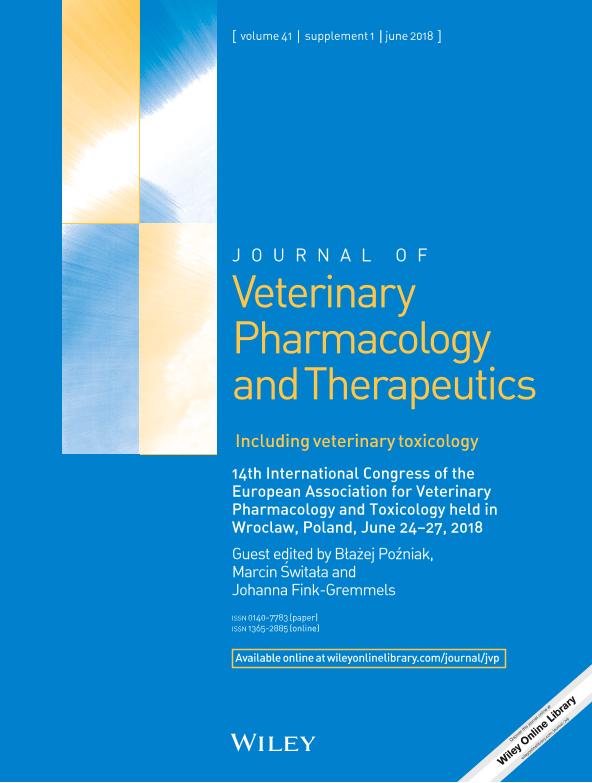Mostrar el registro sencillo del ítem
dc.contributor.author
Viviani, Paula

dc.contributor.author
Virkel, Guillermo Leon

dc.contributor.author
Luque, Sonia Elisabet

dc.contributor.author
Lloberas, Maria Mercedes

dc.contributor.author
Lanusse, Carlos Edmundo

dc.contributor.author
Lifschitz, Adrian Luis

dc.date.available
2022-10-20T10:18:14Z
dc.date.issued
2018
dc.identifier.citation
Modulation of metabolic and transport processes: a valuable tool for improving anthelmintic efficacy?; 14th International Congress of the European Association for Veterinary Pharmacology and Toxicology; Wroclaw; Polonia; 2018; 73-74
dc.identifier.issn
0140-7783
dc.identifier.uri
http://hdl.handle.net/11336/174024
dc.description.abstract
In vivo modulation of drug metabolizing enzymes and transporters may delay the elimination and enhance the systemic availability of anthelmintic compounds. Parasite exposure to the active molecules can be enhanced through their combination with transport modulators or other active anthelmintics. However, the practical relevance of such interactions is unknown. This work aims at assessing the occurrence of PK/PD interactions between (a) oxfendazole and triclabendazole; (b) moxidectin and loperamide; and (c) abamectin and ivermectin/itraconazole in lambs.Materials and MethodsLambs parasitized with nematodes highly resistant to benzimidazole and macrocyclic lactones were used.Experiment 1: Lambs (three groups, n=7 each) were treated with oxfendazole (5 mg/kg PO), triclabendazole (12 mg/kg PO) or their combination;Experiment 2: Lambs (two groups, n=7 each) were treated with moxidectin (0.2 mg/kg SC) alone or in combination with loperamide (0.16 mg/kg PO) and pluronic 123;Experiment 3: Lambs (two groups, n=10 each) were treated with abamectin (0.2 mg/kg SC) alone or in combination with ivermectin (0.2 mg/kg SC) and itraconazole (30 mL PO). Drug/metabolite concentrations in plasma were measured (days 0-15). The faecal egg count reduction test (FECRT) was used as a measure of nematodicidal efficacy.ResultsExperiment 1: Coadministration resulted in an increase in both the plasma AUC0-LOQ and MRT of the metabolite fenbendazole sulfone (p<0.05), whereas all the PK parameters for triclabendazole sulfone were significantly decreased. Efficacy rose from 47.2 and 55.4 % (single administration) to 75.7 % (coadministration).Experiment 2: No differences in PK parameters were observed upon coadministration. Efficacies were 77.1 and 71.2 %, respectively, for the single and combined treatments. Experiment 3: Exposure to ivermectin and itraconazole resulted in an increase in abamectin Cmax and AUC0-LOQ (not significant). Efficacies were 0 % for both treatments.ConclusionsCombination of active principles with modulators and other active compounds has been advocated as an alternative to enhance anthelmintic efficacy. However, clinical efficacy against resistant nematodes remains elusive in practical terms. In spite of proven in vitro pharmacological interactions, translation to clinical settings shows that in vivo trials are needed in order to assess the real impact of modulators and combined therapies in parasite control.
dc.format
application/pdf
dc.language.iso
eng
dc.publisher
Wiley

dc.rights
info:eu-repo/semantics/openAccess
dc.rights.uri
https://creativecommons.org/licenses/by-nc-sa/2.5/ar/
dc.subject
Metabolism
dc.subject
Transport
dc.subject
Anthelmintics
dc.subject
Ruminants
dc.subject.classification
Otras Ciencias Veterinarias

dc.subject.classification
Ciencias Veterinarias

dc.subject.classification
CIENCIAS AGRÍCOLAS

dc.title
Modulation of metabolic and transport processes: a valuable tool for improving anthelmintic efficacy?
dc.type
info:eu-repo/semantics/publishedVersion
dc.type
info:eu-repo/semantics/conferenceObject
dc.type
info:ar-repo/semantics/documento de conferencia
dc.date.updated
2022-10-11T14:23:42Z
dc.identifier.eissn
1365-2885
dc.journal.volume
41
dc.journal.pagination
73-74
dc.journal.pais
Reino Unido

dc.journal.ciudad
Oxford
dc.description.fil
Fil: Viviani, Paula. Consejo Nacional de Investigaciones Científicas y Técnicas. Centro Científico Tecnológico Conicet - Tandil. Centro de Investigación Veterinaria de Tandil. Universidad Nacional del Centro de la Provincia de Buenos Aires. Centro de Investigación Veterinaria de Tandil. Provincia de Buenos Aires. Gobernación. Comision de Investigaciones Científicas. Centro de Investigación Veterinaria de Tandil; Argentina
dc.description.fil
Fil: Virkel, Guillermo Leon. Consejo Nacional de Investigaciones Científicas y Técnicas. Centro Científico Tecnológico Conicet - Tandil. Centro de Investigación Veterinaria de Tandil. Universidad Nacional del Centro de la Provincia de Buenos Aires. Centro de Investigación Veterinaria de Tandil. Provincia de Buenos Aires. Gobernación. Comision de Investigaciones Científicas. Centro de Investigación Veterinaria de Tandil; Argentina
dc.description.fil
Fil: Luque, Sonia Elisabet. Consejo Nacional de Investigaciones Científicas y Técnicas. Centro Científico Tecnológico Conicet - Tandil. Centro de Investigación Veterinaria de Tandil. Universidad Nacional del Centro de la Provincia de Buenos Aires. Centro de Investigación Veterinaria de Tandil. Provincia de Buenos Aires. Gobernación. Comision de Investigaciones Científicas. Centro de Investigación Veterinaria de Tandil; Argentina
dc.description.fil
Fil: Lloberas, Maria Mercedes. Instituto Nacional de Tecnología Agropecuaria. Centro Regional Buenos Aires Sur. Estación Experimental Agropecuaria Balcarce. Agencia de Extensión Rural Balcarce; Argentina
dc.description.fil
Fil: Lanusse, Carlos Edmundo. Consejo Nacional de Investigaciones Científicas y Técnicas. Centro Científico Tecnológico Conicet - Tandil. Centro de Investigación Veterinaria de Tandil. Universidad Nacional del Centro de la Provincia de Buenos Aires. Centro de Investigación Veterinaria de Tandil. Provincia de Buenos Aires. Gobernación. Comision de Investigaciones Científicas. Centro de Investigación Veterinaria de Tandil; Argentina
dc.description.fil
Fil: Lifschitz, Adrian Luis. Consejo Nacional de Investigaciones Científicas y Técnicas. Centro Científico Tecnológico Conicet - Tandil. Centro de Investigación Veterinaria de Tandil. Universidad Nacional del Centro de la Provincia de Buenos Aires. Centro de Investigación Veterinaria de Tandil. Provincia de Buenos Aires. Gobernación. Comision de Investigaciones Científicas. Centro de Investigación Veterinaria de Tandil; Argentina
dc.relation.alternativeid
info:eu-repo/semantics/altIdentifier/url/https://web.archive.org/web/20180502161055/https://eavpt2018.pl/
dc.relation.alternativeid
info:eu-repo/semantics/altIdentifier/url/https://onlinelibrary.wiley.com/toc/13652885/2018/41/S1
dc.conicet.rol
Autor

dc.coverage
Internacional
dc.type.subtype
Congreso
dc.description.nombreEvento
14th International Congress of the European Association for Veterinary Pharmacology and Toxicology
dc.date.evento
2018-06-24
dc.description.ciudadEvento
Wroclaw
dc.description.paisEvento
Polonia

dc.type.publicacion
Journal
dc.description.institucionOrganizadora
European Association for Veterinary Pharmacology and Toxicology
dc.source.revista
Journal of Veterinary Pharmacology and Therapeutics

dc.date.eventoHasta
2018-06-27
dc.type
Congreso
Archivos asociados
